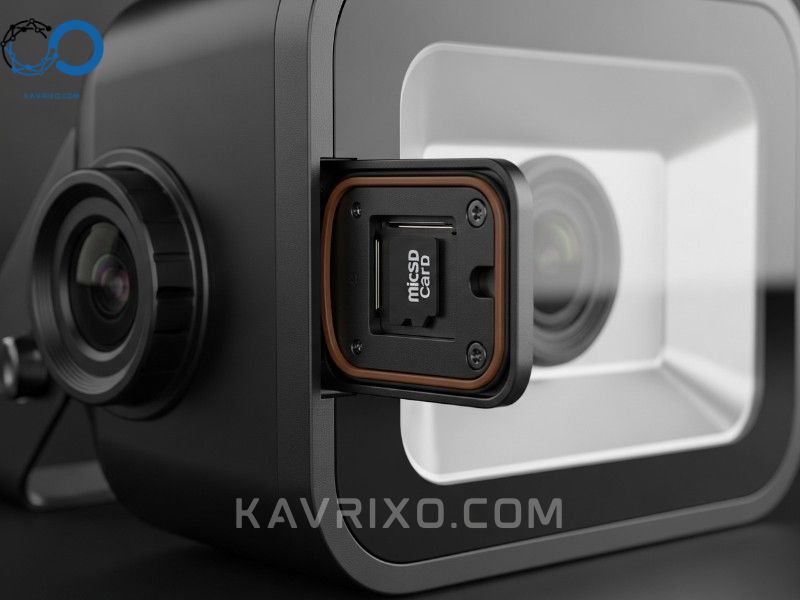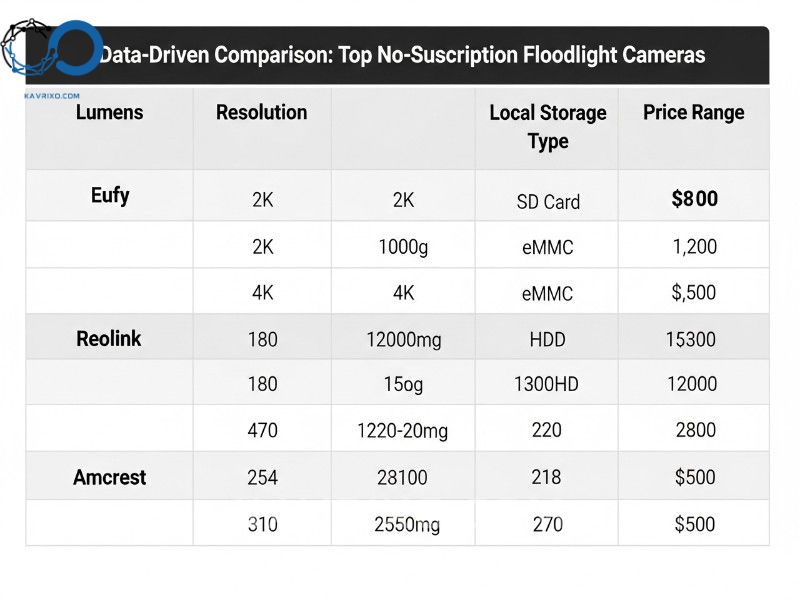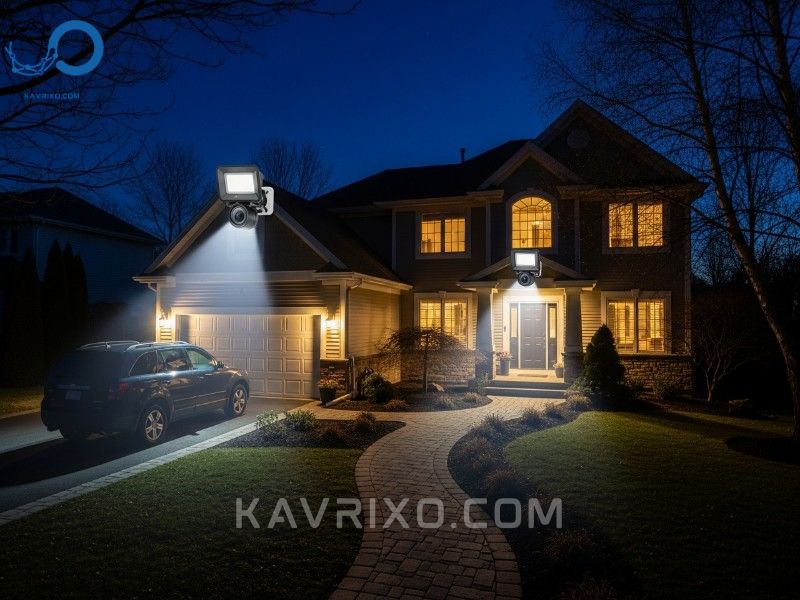In an era dominated by subscription services, the thought of adding yet another monthly fee—just to access video footage of your own home—can be frustrating. For discerning homeowners and privacy-conscious consumers, finding the best floodlight camera without subscription is paramount. These devices offer the powerful deterrent of high-intensity lighting combined with smart recording, all while keeping your data local and your wallet closed after the initial purchase.
This comprehensive guide delves into the specifics of no-subscription security, offering a detailed floodlight camera comparison and highlighting the crucial technical specifications that define the best security floodlight options on the market today. We’ll help you navigate the features that truly matter, ensuring you invest in a robust, one-time purchase solution that offers peace of mind without the endless recurring charges.
Contents
- 1 Why Ditch the Monthly Bill? The Appeal of Local Storage Security Systems
- 2 Essential Features for the Best Floodlight Camera Without Subscription
- 3 Top Contenders: Floodlight Camera Comparison Breakdown
- 4 Deep Dive: Evaluating True Cost of Ownership (TCO)
- 5 Setting Up Your Best Security Floodlight System for Maximum Efficiency
- 6 Common Questions Before Buying a No-Subscription Floodlight Camera
- 7 Conclusion: Securing Your Home Smartly and Economically
Why Ditch the Monthly Bill? The Appeal of Local Storage Security Systems
The shift toward cloud services has made security monitoring incredibly convenient, but this convenience often comes at a steep price: compulsory monthly fees ranging from $3 to $30 per device or per household. For users installing multiple cameras, these fees quickly compound, turning a seemingly affordable initial investment into a significant long-term expense.
Choosing the best floodlight camera without subscription is fundamentally an economic and privacy-driven decision.
Understanding Subscription Models vs. One-Time Purchases
Traditional, subscription-based cameras (like many popular brands) rely on the cloud for essential functionality, such as viewing event history, using advanced AI detection (person, vehicle, package), and accessing rich notifications. If you stop paying, the camera often reverts to little more than a live-view device, severely limiting its utility as a reliable security tool.
A no-subscription model, by contrast, relies on a one-time hardware purchase that includes onboard or locally networked storage (like MicroSD cards, USB drives, or Network Attached Storage—NAS). All critical functions—recording, motion alerts, and often even the advanced AI processing—are handled directly by the camera’s internal chip (edge computing). This means the security functionality you paid for remains yours, indefinitely, without any ongoing financial commitment.
Data Privacy and Local Storage Benefits
Beyond cost savings, privacy is a major motivator. When video footage is stored locally, it remains within your property’s network perimeter. It is not constantly being uploaded to third-party servers thousands of miles away.
For individuals concerned about data breaches, unauthorized access, or compliance with strict data protection regulations (even for home use), local storage offers superior control. When you select the best floodlight camera without subscription, you are selecting a system where you maintain ownership of your data, deciding who, if anyone, has access to it.

Essential Features for the Best Floodlight Camera Without Subscription
While eliminating monthly fees is the goal, the camera must still perform its primary function: providing superior security monitoring and illumination. Here are the critical technical specifications you must evaluate when performing a thorough floodlight camera comparison.
Storage Solutions: MicroSD, NAS, and Onboard Memory
The backbone of any no-subscription system is its storage mechanism. This is where the video evidence lives.
1. MicroSD Card Support (The Standard)
Most consumer-grade no-fee floodlight cameras utilize MicroSD cards. Look for cameras that support high-capacity cards (e.g., up to 128GB or 256GB). A 128GB card typically holds several weeks of event-triggered footage, depending on the resolution and compression (H.264 vs. H.265). A crucial feature is loop recording, where the camera automatically overwrites the oldest footage when the card is full.
2. Built-in eMMC Storage (High Reliability)
Some premium options, often considered the best security floodlight models, feature embedded MultiMediaCard (eMMC) storage. This is internal flash memory built directly into the camera hardware. While generally reliable and fast, it cannot be easily upgraded by the user. Systems like these often have 4GB, 8GB, or 16GB of fixed storage.
3. Network Attached Storage (NAS) or HomeBase Integration
For users seeking maximum storage capacity and redundancy, look for cameras that support NAS integration or require a dedicated HomeBase unit (a local hub). Connecting the camera to a NAS allows for virtually limitless storage, professional-grade backup solutions, and centralized management of multiple devices. This setup is ideal for those building a comprehensive, multi-camera system where continuity of footage is paramount.

Read more: The Rise of Ultra HD Surveillance: Why an 8K Security Camera is the New Standard
Illumination Power and Smart Detection (Lux and Lumens)
A floodlight camera isn’t just a camera; it’s a powerful light source designed to deter intruders and capture high-quality color night vision.
- Lumens Output: The brightness is measured in lumens. Entry-level floodlight cameras often start around 2,000 lumens, which is sufficient for small patios. However, for illuminating large driveways or yards, look for models offering 2,500 lumens or higher. The best security floodlight cameras often push 3,000 lumens or more, rivaling traditional hardwired fixtures.
- Color Rendering Index (CRI): While often overlooked, CRI measures how accurately the light renders colors. A higher CRI (closer to 100) means better identification of colors (like clothing or vehicle paint) in the recorded footage, even at night.
- Motion Activation: The light should activate instantly based on highly customizable motion zones and schedules. The ability to fine-tune sensitivity (PIR vs. pixel-based detection) is essential to avoid constant false alerts triggered by passing cars or neighborhood pets.
Read more: The Ultimate Guide to the 4K Night Vision Camera: Unrivaled Clarity in the Dark
Resolution and Field of View (4K vs. 2K)
Resolution dictates the clarity and detail of the image, critical for identifying faces and license plates.
- 2K (1440p): Currently the sweet spot for most no-subscription cameras. It offers a significant detail improvement over 1080p without generating enormous file sizes that quickly fill up local storage.
- 4K (2160p): While offering maximum detail, 4K footage consumes massive storage space. Only opt for 4K if your local storage solution is extremely generous (e.g., NAS or a very large MicroSD card) and your network bandwidth can handle the high data rate for live viewing.
- Field of View (FOV): Look for wide angles, typically between 140 and 160 degrees diagonally. Some advanced models feature dual lenses or adjustable PTZ (Pan-Tilt-Zoom) capabilities, allowing a single camera to cover a vast area, minimizing blind spots.
Installation and Connectivity (Wired vs. Wireless)
Floodlight cameras are primarily available in two configurations, each impacting ease of installation and reliability:
- Hardwired (Wired Power): These cameras connect directly to existing electrical junction boxes (like replacing an old porch light). They offer continuous power, ensuring reliable recording and light activation 24/7. This is the most common format for the best floodlight camera without subscription because constant power is often necessary to run the sophisticated local processing chips required for no-fee AI features.
- Battery-Powered (Wireless Power): These are extremely rare in the floodlight category because the immense power required to run bright LED lights and continuous recording rapidly drains batteries. If you find a “wireless” floodlight camera, verify its lumen output and expected battery life, as it often sacrifices brightness or needs frequent recharging, making it less reliable for critical security illumination.
Top Contenders: Floodlight Camera Comparison Breakdown
To illustrate what makes a system the best floodlight camera without subscription, we will examine several high-performing models that prioritize local storage and comprehensive features without mandatory fees.
Review 1: The Premium Local Storage Option (Eufy Floodlight Cam 2 Pro Example)
Eufy is often cited as a leader in the no-subscription security space, and their Floodlight Cam 2 Pro exemplifies this commitment.
Key No-Fee Features:
- Onboard Storage: Utilizes 8GB of integrated eMMC storage. While fixed, this is sufficient for typical event-triggered recording and eliminates the need for user-installed MicroSD cards.
- Resolution: 2K clarity, providing excellent detail without overburdening the local storage.
- Lighting: Impressive 3,000-lumen adjustable lighting with three separate LED panels, offering extensive coverage.
- Advanced AI: Features local, edge-based AI for human, pet, and vehicle detection, allowing for highly accurate, subscription-free alerts. The camera can even auto-track subjects using its motorized 360-degree pan and tilt functionality, a feature usually reserved for high-end, subscription-heavy devices.
Why it stands out: This camera offers high-end PTZ functionality and powerful illumination while processing all smart alerts locally. It is arguably the gold standard for those seeking a single, feature-rich best security floodlight that requires absolutely no ongoing fees.

Review 2: The Budget-Friendly No-Fee Choice (Reolink Floodlight Cam Example)
Reolink has established itself as a go-to brand for affordability matched with local storage capability. Their floodlight cameras are often more straightforward but highly effective.
Key No-Fee Features:
- Storage: Supports up to 256GB MicroSD cards, offering significantly more local storage capacity than eMMC-only models. They also support FTP/NAS integration for professional archiving.
- Resolution: Typically 2K or 4MP Super HD, ensuring clear footage.
- Lighting: Generous 2,000–2,500 lumens, highly suitable for standard residential use.
- Flexibility: Reolink generally provides a wider range of connectivity options, making it easier to integrate into existing NVR (Network Video Recorder) systems, which is a major draw for users upgrading from traditional CCTV setups.
Why it stands out: Reolink excels at offering high storage flexibility and robust features at a lower entry cost. If your priority is maximum local storage capacity via MicroSD or NAS without breaking the bank, this option consistently performs well in any floodlight camera comparison.
Review 3: The Hardwired Professional Alternative (Amcrest/Lorex NVR Integration)
For users who want continuous 24/7 recording, rather than just event-triggered clips, integrating a floodlight camera into a dedicated NVR system is the answer. While the NVR hardware is an upfront cost, the surveillance stream is entirely subscription-free.
Key No-Fee Features:
- Storage: Infinite capacity, constrained only by the size of the hard drives installed in the NVR (often 4TB to 16TB).
- Protocol: Relies on standard protocols like ONVIF, ensuring compatibility across different professional-grade cameras and recorders.
- Power: These are strictly hardwired PoE (Power over Ethernet) or standard A/C wire devices, offering maximum reliability.
- Functionality: The floodlight component is typically triggered by the camera’s motion detection, but the video stream is recorded continuously to the NVR, guaranteeing that no moment is missed.
Why it stands out: For the ultimate in subscription-free security and professional-grade continuous recording, selecting a high-quality floodlight camera designed for NVR integration (like certain Amcrest or Lorex models) provides the most reliable long-term solution. This setup truly represents the pinnacle of the best floodlight camera without subscription for serious security enthusiasts.
Deep Dive: Evaluating True Cost of Ownership (TCO)
The initial sticker price of a no-subscription camera might occasionally be higher than a comparable subscription-based model. However, when evaluating the True Cost of Ownership (TCO) over several years, the savings become undeniable, making the best floodlight camera without subscription a wise financial choice.
Calculating ROI for No-Subscription Cameras
Let’s assume a homeowner installs four floodlight cameras.
| Item | Subscription Model (Monthly Cost $5/cam) | No-Subscription Model (Eufy/Reolink) |
|---|---|---|
| Initial Hardware Cost (4 Cams) | $800 | $1,000 (Higher initial cost for local processing) |
| Monthly Subscription Fee (4 Cams) | $20 ($240/year) | $0 |
| 1-Year Total Cost | $1,040 | $1,000 |
| 3-Year Total Cost | $1,520 | $1,000 |
| 5-Year Total Cost | $2,000 | $1,000 |
As this comparison clearly shows, the Return on Investment (ROI) for a no-subscription system becomes substantial after just two years. By the five-year mark, the homeowner using the best floodlight camera without subscription has saved $1,000, money that would otherwise have been spent on cloud storage access.
Hidden Costs: Power, Installation, and Data Retrieval
While no-fee cameras eliminate subscription costs, potential buyers should be aware of other minor costs:
- MicroSD Card Refresh: If you rely solely on MicroSD cards, they have a finite lifespan, especially under heavy write loads (continuous recording). Expect to replace them every 3–5 years. This is a minimal cost but should be factored in.
- Professional Installation: If you are uncomfortable dealing with electrical wiring for a hardwired floodlight camera, hiring an electrician is a one-time cost. This cost is identical for both subscription and non-subscription hardwired models.
- Power Consumption: Modern LED floodlights are highly efficient. While they use more power than a standard camera, the increase in your electric bill is negligible compared to the cost of a monthly subscription.

Setting Up Your Best Security Floodlight System for Maximum Efficiency
Purchasing the hardware is only the first step. To ensure your investment operates at its peak, careful setup and maintenance are crucial.
Optimizing Motion Detection Zones
The key to preventing notification fatigue and ensuring critical events are captured is accurate motion zone configuration. The best floodlight camera without subscription often uses local, edge-based AI for object detection, which is typically faster and more accurate than cloud-based systems.
- Define Exclusion Zones: Use the camera’s app to draw specific areas in the frame (like a busy public sidewalk or a neighbor’s yard) that should be ignored. This significantly reduces false alarms.
- Adjust Sensitivity: Experiment with the PIR (Passive Infrared) or pixel sensitivity settings. High sensitivity might capture every rustling leaf, while low sensitivity might miss a slow-moving intruder. Find the balance that suits your environment.
- Utilize AI Filters: Ensure the camera is set to primarily alert you to people and vehicles, rather than just general motion. This ensures that the light and siren (if equipped) only activate when a genuine threat is detected.
Maintaining Local Storage Integrity
Local storage requires minimal maintenance, but attention to detail ensures longevity and reliability.
- Choose High Endurance Cards: If using MicroSD cards, always select “High Endurance” cards designed specifically for continuous read/write cycles in security cameras. Standard consumer cards will fail much faster.
- Format Regularly: It is good practice to format the MicroSD card through the camera’s app every 6–12 months. This keeps the file system clean and helps prevent corruption.
- Monitor Storage Health: Periodically check the storage status via the camera app. Some advanced cameras will notify you if the storage medium is nearing its failure threshold, allowing you to replace it proactively.

Common Questions Before Buying a No-Subscription Floodlight Camera
Q: Will I still get instant notifications without a subscription?
A: Yes, absolutely. Modern no-subscription cameras perform detection and analysis right on the device (edge computing). They use a secure, encrypted push notification service to send the alert to your phone instantly. The only difference is that the recorded video clip is retrieved directly from your local storage (eMMC, MicroSD, or NAS) rather than a cloud server.
Q: Are Wi-Fi or cellular data needed for a no-subscription camera?
A: Wi-Fi is still essential. The camera needs an internet connection to send you live view streams and push notifications to your mobile device when you are away from home. The key distinction is that the storage and AI processing are local, meaning the camera doesn’t rely on the cloud to function as a security tool.
Q: Can I use voice commands (Alexa/Google Home) with a local storage camera?
A: Most reputable manufacturers of the best floodlight camera without subscription (like those included in our floodlight camera comparison) ensure integration with smart home ecosystems. You can typically use voice commands to view the live feed on a smart display or turn the floodlight on or off. These functions usually require only a basic cloud connection for authentication, not a monthly fee for storage or alerts.
Q: What is the benefit of continuous recording (NVR) vs. event recording?
A: Event recording saves space by only recording clips when motion is detected. Continuous recording (requiring an NVR or large NAS) records 24/7. Continuous recording is generally safer because it captures the lead-up and follow-through of an event, even if the motion sensor didn’t trigger immediately. If you need 24/7 coverage without subscription fees, you must choose a model compatible with a local NVR system.
Conclusion: Securing Your Home Smartly and Economically
The market for home security has matured significantly, offering powerful alternatives to the monthly billing cycle. Investing in the best floodlight camera without subscription ensures that you retain control over your data, maximize your long-term savings, and still benefit from cutting-edge features like 2K resolution, powerful illumination, and accurate edge-based AI detection.
By prioritizing local storage solutions and carefully reviewing the specifications provided in this floodlight camera comparison, you can confidently choose a best security floodlight that serves as a robust, permanent fixture in your home security arsenal. The peace of mind that comes from knowing your surveillance system is truly yours—without hidden fees or privacy compromises—is priceless.

